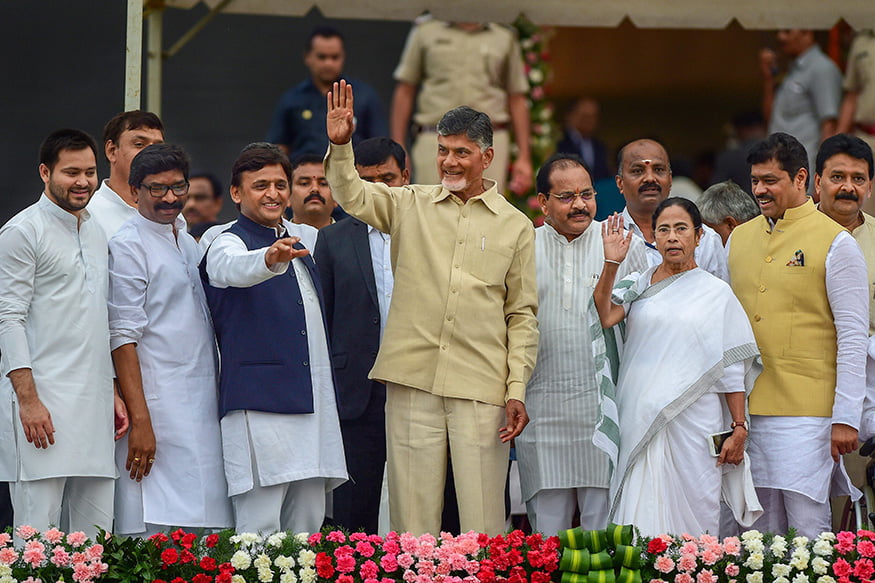Lack Of Chemistry On Ground May Upset 2019 Arithmetic Of Grand Alliance

Will the grand alliance of anti-BJP parties succeed? Now that regional chieftains and the national Congress have set aside differences to put up a united fight against the common enemy, this is the next logical question. The answer to it lies, to use a cliche, not in arithmetic but in chemistry.
Let’s elaborate. All parties have their exclusive support bases in their respective states, and some beyond them. It is reflected in the mean vote share they maintain across elections. The core vote base depends on the circumstance of origin of each party. In most cases across the country, caste defines the base. Since one social grouping is not enough to ensure victory, parties extend outreach to other castes in the same social strata. This is particularly true of north Indian states where political mobilization, along caste lines has a deep history.
Arithmetic suggests that if vote bases of two or more big parties combine, it becomes a win-win situation for the alliance. The cumulative numbers are a formidable challenge for any opposition. For example, the BSP of Mayawati, barring minor fluctuations from election to election, commands a mean vote share of 22 per cent (it was 22.23 per cent in 2017 Assembly elections) in Uttar Pradesh. The same goes for Akhilesh Yadav’s Samajwadi Party, which commands a similar vote share (it had 21.82 per cent in 2017). Their combined strength comes close to 44 per cent. It goes higher if smaller parties such as RLD join in.
In the 2014 general elections, the combined votes of the SP and the BSP were higher than that of the BJP in 41 seats. Had they fought together, under our first-past-the-post system, the MP count of the latter would have been much lower. Having learnt a bitter lesson in the 2014 and 2017 elections, and enthused by the by-poll results in Gorakhpur and Phulpur, where they defeated the BJP by joining forces, the parties have decided to come together again.
So far so good. But does arithmetic count always? Not necessarily. A coalition of leaders does not mean automatic coalition of their party’s followers at the ground level. At the booth level, the workers have to bury old rivalries and deep-rooted caste conflicts, agree on acceptability of the common candidate and campaign together. This is easier said than done. Actually, confusion among ranks could end up as a boon for the rival. This is where chemistry comes in. Unless the chemistry is right on the ground, arithmetic won’t work. Transferability of votes is an important matter. The traditional voters of one party are usually reluctant to vote for the candidate of another party. An agreement among top leaders may not enthuse loyalists of respective parties to troop to the booths and vote for the joint candidate. It is possible they would not vote at all. This was evident in the alliance of the Samajwadi Party and the Congress in Uttar Pradesh in the Assembly elections of 2017. Despite the high voltage joint campaign by Akhilesh Yadav and Rahul Gandhi, the votes were not transferred to agreed candidates at the ground level.
This is a reason, say poll observers in UP, why the Congress has been kept out of the grand alliance in the state. It has a dedicated 6.5 per cent vote share in the state. The voters are generally upper caste Brahmins and Thakurs. If they don’t vote for the Congress, they would vote for the next best alternative, the BJP, but never for the SP or the BSP. By contesting alone, the party would ensure that its votes don’t shift to the BJP. It’s a help to the alliance in a roundabout way.
The BSP’s votes, it is generally believed, are transferable. That offers Mayawati a unique advantage in seat negotiations. The SP, with some coaxing of its ranks, can ensure transfer of votes to a BSP candidate. Since this arrangement worked well in Phulpur and Gorakhpur, both are confident about the prospects of an alliance in 2019. But is similar meeting of minds possible in other states too? The arithmetic part is fine but all anti-BJP parties would need chemistry on the ground to defeat the BJP. It won’t be easy.
Disclaimer: The views and opinions expressed in this article are those of the authors and do not necessarily reflect the official policy or position of Odisha Bytes.

Comments are closed.